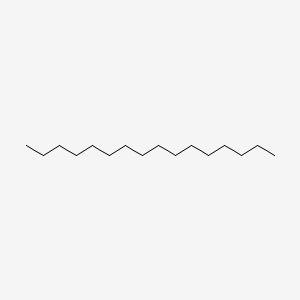| MeSH term | MeSH ID | Detail |
|---|---|---|
| Lupus Erythematosus, Systemic | D008180 | 43 associated lipids |
| Body Weight | D001835 | 333 associated lipids |
| Coronary Disease | D003327 | 70 associated lipids |
| Peritonitis | D010538 | 38 associated lipids |
| Hyperplasia | D006965 | 34 associated lipids |
| Glomerulonephritis | D005921 | 35 associated lipids |
| Encephalomyelitis, Autoimmune, Experimental | D004681 | 26 associated lipids |
| Keratosis | D007642 | 9 associated lipids |
| Serratia Infections | D016868 | 2 associated lipids |
Hexadecane
Hexadecane is a lipid of Fatty Acyls (FA) class. The involved functions are known as Analyte. The related lipids are Fatty Acids and palmitoleic acid.
Cross Reference
Introduction
To understand associated biological information of Hexadecane, we collected biological information of abnormalities, associated pathways, cellular/molecular locations, biological functions, related genes/proteins, lipids and common seen animal/experimental models with organized paragraphs from literatures.
What diseases are associated with Hexadecane?
There are no associated biomedical information in the current reference collection.
Possible diseases from mapped MeSH terms on references
We collected disease MeSH terms mapped to the references associated with Hexadecane
PubChem Associated disorders and diseases
What pathways are associated with Hexadecane
There are no associated biomedical information in the current reference collection.
PubChem Biomolecular Interactions and Pathways
Link to PubChem Biomolecular Interactions and PathwaysWhat cellular locations are associated with Hexadecane?
There are no associated biomedical information in the current reference collection.
What functions are associated with Hexadecane?
Related references are published most in these journals:
| Function | Cross reference | Weighted score | Related literatures |
|---|
What lipids are associated with Hexadecane?
Related references are published most in these journals:
| Lipid concept | Cross reference | Weighted score | Related literatures |
|---|
What genes are associated with Hexadecane?
There are no associated biomedical information in the current reference collection.
What common seen animal models are associated with Hexadecane?
There are no associated biomedical information in the current reference collection.
NCBI Entrez Crosslinks
All references with Hexadecane
Download all related citations| Authors | Title | Published | Journal | PubMed Link |
|---|---|---|---|---|
| Aurich H and Eitner G | [Oxidation of n-hexadecane by Acinetobacter calco-aceticus. Conditions and induction of involved enzymes]. | 1973 | Z. Allg. Mikrobiol. | pmid:4774654 |
| Schneider H et al. | Plasma membrane from Candida tropicalis grown on glucose or hexadecane. II. Biochemical properties and substrate-induced alterations. | 1979 | Biochim. Biophys. Acta | pmid:486444 |
| Einsele A and Fiechter A | Growth behavior of Candida tropicalis in batch fermentation processes on n-hexadecane as substrate. | 1972 | Pathol Microbiol (Basel) | pmid:5019324 |
| Sukatsch DA and Johnson MJ | Bacterial cell production from hexadecane at high temperatures. | 1972 | Appl Microbiol | pmid:5021971 |
| Einsele A et al. | Respiratory activity of Candida tropicalis during growth on hexadecane and on glucose. | 1972 | Arch Mikrobiol | pmid:5028088 |
| Molé PA et al. | Adaptation of muscle to exercise. Increase in levels of palmityl Coa synthetase, carnitine palmityltransferase, and palmityl Coa dehydrogenase, and in the capacity to oxidize fatty acids. | 1971 | J. Clin. Invest. | pmid:5096516 |
| Falconer WE et al. | Effects of dose, dose rate, and trace impurities on n-hexadecane radiolysis. | 1971 | Radiat. Res. | pmid:5559385 |
| Bloedow DC and Hayton WL | Effects of lipids on bioavailability of sulfisoxazole acetyl, dicumarol, and griseofulvin in rats. | 1976 | J Pharm Sci | pmid:57233 |
| Sapozhnikova GP and Krauzova VI | [Activity and substrate specificity of the alcohol dehydrogenases of n-alkane oxidizing yeasts]. | 1979 Sep-Oct | Mikrobiologiia | pmid:574184 |
| Shavlovskii GM and Fedorovich DV | [The activity of enzymes involved in synthesis and hydrolysis of flavin adenine dinucleotide is Pichia guilliermondii studies at different levels of flavinogenesis]. | 1977 Sep-Oct | Mikrobiologiia | pmid:600094 |
